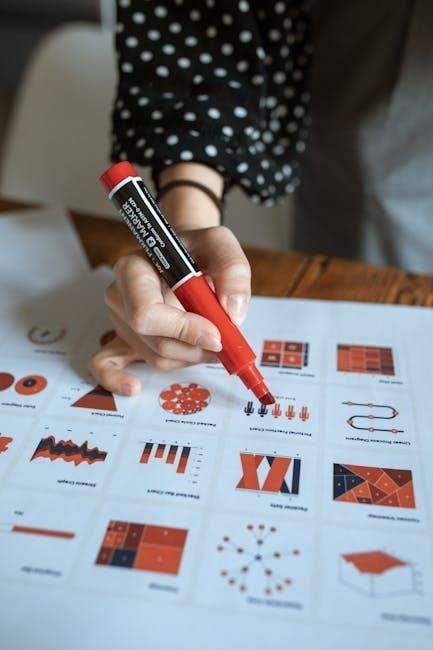Statistics project examples in PDF format offer practical insights into data analysis‚ covering topics like income prediction‚ transport studies‚ and regression applications‚ providing downloadable resources for learners.
1.1. What are Statistics Projects?
Statistics projects are structured analyses that use data to address specific questions or hypotheses. They often involve collecting‚ organizing‚ and interpreting data to draw meaningful conclusions. These projects can range from descriptive analyses to complex inferential studies‚ utilizing tools like regression and hypothesis testing. Many statistics projects are available in PDF format‚ offering detailed reports‚ case studies‚ and visualizations. Examples include income prediction models‚ transport statistics‚ and health-related analyses. These projects provide practical insights into real-world applications of statistical methods‚ making them valuable for students and researchers. They also serve as educational tools‚ helping learners understand key concepts like variability‚ trends‚ and correlations. By working on statistics projects‚ individuals gain hands-on experience in data processing‚ interpretation‚ and communication‚ essential skills in various fields.
1.2. Importance of Statistics Projects in Education
Statistics projects play a crucial role in education by fostering a deeper understanding of data analysis and interpretation. They enable students to apply theoretical concepts to real-world problems‚ enhancing critical thinking and analytical skills. Through these projects‚ learners gain hands-on experience in formulating hypotheses‚ collecting data‚ and drawing meaningful conclusions. Educationally‚ statistics projects encourage collaboration and problem-solving‚ preparing students for practical challenges in various fields. They also promote the development of communication skills‚ as students present their findings in a structured and visually appealing manner. By engaging with statistics projects‚ students build a strong foundation in data-driven decision-making‚ which is essential for academic and professional success. These projects further bridge the gap between theory and practice‚ making learning interactive and impactful for students at all educational levels.

Types of Statistics Projects
Statistics projects are categorized into descriptive and inferential types‚ focusing on data analysis and interpretation. They involve techniques like regression and hypothesis testing‚ enhancing educational and research applications.
2.1. Descriptive Statistics Projects
Descriptive statistics projects focus on summarizing and describing datasets to understand basic features such as central tendency‚ variability‚ and distribution. These projects often involve calculating measures like mean‚ median‚ mode‚ and standard deviation. They also include creating visual representations like histograms‚ bar charts‚ and box plots to communicate data insights effectively. Examples include analyzing exam scores to identify class performance‚ studying the average rainfall in a region‚ or summarizing survey responses about customer satisfaction. These projects are foundational‚ helping students and researchers organize and interpret data before moving to more complex analyses. By emphasizing clarity and simplicity‚ descriptive statistics projects provide a solid starting point for understanding patterns and trends in data.
2.2. Inferential Statistics Projects
Inferential statistics projects involve making predictions or inferences about a population based on sample data. These projects often use techniques like hypothesis testing‚ confidence intervals‚ and regression analysis to draw conclusions. Examples include analyzing the effect of a new drug compared to a placebo‚ determining if there’s a significant difference in average exam scores between two groups‚ or predicting income levels based on education. These projects help researchers make informed decisions by generalizing findings from a sample to a larger population. They are essential in research‚ allowing for actionable insights and informed decision-making. Inferential statistics projects are more complex than descriptive ones‚ requiring a deeper understanding of statistical concepts and their applications. They are widely used in fields like medicine‚ social sciences‚ and business to solve real-world problems.
Educational Applications of Statistics Projects
Statistics projects foster data literacy‚ analytical thinking‚ and problem-solving skills‚ offering hands-on learning experiences that prepare students for real-world challenges and future careers in data-driven fields.
3.1. Statistics Projects for High School Students
Statistics projects for high school students are designed to introduce foundational concepts of data analysis and interpretation. These projects often focus on relatable topics‚ such as sports analytics‚ school survey results‚ or environmental studies‚ to engage young learners. By collecting and analyzing data‚ students develop critical thinking and problem-solving skills. For example‚ a project might involve calculating batting averages for a school baseball team or examining the relationship between study hours and exam scores. Such tasks help students understand basic statistical methods like mean‚ median‚ and mode. Additionally‚ these projects encourage the use of tools like Excel or Google Sheets for data visualization‚ making complex concepts accessible. They also foster creativity and presentation skills‚ as students often share their findings in class. These experiences prepare students for more advanced studies and real-world applications of statistics.
3.2. Statistics Projects for College Students
Statistics projects for college students often involve advanced techniques and real-world applications‚ preparing them for professional careers. These projects may focus on hypothesis testing‚ regression analysis‚ or predictive modeling‚ using tools like Python‚ R‚ or SPSS. For example‚ students might analyze the impact of social media usage on mental health or predict stock prices using historical data. Such projects deepen understanding of statistical concepts like confidence intervals‚ correlation‚ and probability distributions. They also enhance skills in data visualization‚ interpretation‚ and reporting. College-level projects often require students to collect and analyze large datasets‚ fostering proficiency in statistical software and critical thinking. Additionally‚ these projects encourage collaboration and presentation of findings‚ simulating professional research environments. They are ideal for developing expertise in applied statistics‚ equipping students for roles in data science‚ public health‚ economics‚ or business analytics.

Data Analysis Techniques in Statistics Projects
Data analysis techniques in statistics projects involve methods like data cleaning‚ visualization‚ hypothesis testing‚ regression‚ and probability analysis to draw meaningful insights from datasets.
4.1. Hypothesis Testing Examples
Hypothesis testing is a core data analysis technique in statistics projects‚ enabling researchers to make inferences about populations based on sample data. Common examples include testing the average difference between groups‚ such as comparing the heights of males and females‚ or analyzing the effectiveness of a new drug versus a placebo. In education‚ hypothesis testing can be used to determine if a new teaching method improves student performance. These tests involve setting a null and alternative hypothesis‚ calculating test statistics‚ and interpreting p-values to draw conclusions. Real-world applications include quality control in manufacturing‚ marketing research‚ and social sciences. By applying hypothesis testing‚ researchers can make data-driven decisions with confidence‚ ensuring the validity of their findings in various fields.
4.2. Regression Analysis in Projects
Regression analysis is a powerful statistical technique used to establish relationships between variables in projects. It helps predict outcomes by identifying how dependent variables change in response to independent variables. For example‚ regression can forecast house prices based on size or analyze how study hours affect exam scores. In projects‚ it’s often used to model trends‚ such as sales prediction over time or the impact of marketing campaigns on customer engagement. Simple and multiple linear regression are common methods‚ while logistic regression is applied for binary outcomes. By visualizing data through scatter plots and regression lines‚ researchers can identify patterns and make informed decisions. Regression analysis is widely applied in finance‚ healthcare‚ and social sciences‚ making it a versatile tool for data exploration and modeling in statistics projects.

Tools and Resources for Statistics Projects

Popular tools include R‚ Python‚ Excel‚ and Jupyter Notebooks for data analysis. Resources like Kaggle‚ GitHub‚ and Google Colab offer datasets‚ tutorials‚ and templates for project execution.
5.1. Using R and Rweb for Statistical Procedures
R and Rweb are powerful tools for statistical analysis‚ offering extensive libraries for data manipulation‚ visualization‚ and modeling. R is particularly favored for its flexibility and customizable packages like ggplot2 and dplyr‚ which streamline data processing. Rweb provides a web-based interface‚ making it accessible for beginners and collaborative projects. Both tools support advanced statistical procedures‚ including hypothesis testing‚ regression analysis‚ and machine learning algorithms. They are widely used in academic and professional settings due to their open-source nature and robust community support. For students‚ R and Rweb are excellent for creating interactive and reproducible statistics project examples‚ enabling them to present complex data insights effectively. These tools are essential for anyone aiming to explore and visualize data dynamically.
5.2. Microsoft Excel for Data Processing and Visualization

Microsoft Excel is a widely used tool for data processing and visualization‚ offering a user-friendly interface for managing datasets. Its built-in functions‚ such as formulas and pivot tables‚ enable efficient data organization and analysis. Excel’s charting capabilities allow users to create histograms‚ bar graphs‚ and scatter plots‚ making it ideal for presenting statistical results. Advanced features like data validation and conditional formatting further enhance data handling. While Excel is not as powerful as specialized tools like R for complex statistical modeling‚ it excels in simplicity and accessibility‚ making it a great choice for basic statistics projects. Its versatility and familiarity make it a popular option for students and professionals alike‚ especially for small-scale data analysis and visualization in PDF reports.

Examples of Statistics Projects in PDF Format
Income analysis‚ population trends‚ public health impacts‚ and environmental data are common examples of statistics projects often presented in PDF reports for clarity and professionalism.

6.1. Income Prediction Analysis Report
An income prediction analysis report is a common example of a statistics project in PDF format. This report typically uses regression models to predict income levels based on variables such as education‚ age‚ and occupation. Data is often collected from surveys or public databases and analyzed using tools like R or Excel. The report includes descriptive statistics‚ such as mean income levels and standard deviations‚ as well as inferential statistics‚ like confidence intervals for predictions. Visualizations‚ like scatter plots and bar charts‚ are used to present findings clearly. The report concludes with recommendations for policymakers or educators to improve income equality. This type of project demonstrates the practical application of statistical methods in real-world scenarios and is widely used in academic and professional settings;
6.2. Transport Statistics and Brief Studies
Transport statistics and brief studies are essential for understanding trends in mobility‚ traffic patterns‚ and transportation infrastructure. These projects often analyze data on road accidents‚ public transport usage‚ and traffic congestion. By applying statistical methods like regression analysis and data visualization‚ researchers can identify factors influencing transportation systems. For instance‚ studies might explore how population growth impacts traffic density or how weather conditions affect accident rates. Brief studies are particularly useful for providing insights into specific transportation challenges‚ such as optimizing bus routes or improving pedestrian safety. These analyses are frequently presented in PDF reports‚ making them accessible for policymakers and stakeholders. Such projects highlight the role of statistics in enhancing urban planning and transportation efficiency‚ ultimately contributing to better community outcomes.

Advanced Topics in Statistics Projects
Explore advanced statistical methods like machine learning integration‚ Bayesian analysis‚ and complex regression models. These topics enhance project depth and real-world application in data-driven fields.
7.1. Randomized Observational Study Design
A randomized observational study design combines elements of experimental and observational research. By randomly assigning subjects to groups‚ it minimizes bias and strengthens causal inferences; This method is particularly useful in real-world settings where full experimental control is not feasible. For example‚ researchers might randomly assign participants to different data collection methods to analyze behavioral trends. The randomization ensures that observed differences are more likely due to the variable under study‚ rather than confounding factors. This approach is widely used in fields like public health‚ economics‚ and social sciences. It provides a balanced perspective between experimental rigor and real-world applicability‚ making it a valuable tool for statistics projects focusing on causal relationships and policy evaluations.
7.2. Linear and Logistic Regression Applications
Linear and logistic regression are essential tools in statistical analysis‚ offering insights into relationships between variables. Linear regression is used to predict continuous outcomes‚ such as forecasting sales based on advertising spend‚ while logistic regression predicts binary outcomes‚ like determining the likelihood of a customer purchasing a product. Both methods are widely applied in business‚ healthcare‚ and social sciences. For instance‚ logistic regression can analyze customer churn‚ and linear regression can model energy consumption patterns. These techniques enable researchers to identify trends‚ make predictions‚ and inform decision-making. Their versatility makes them invaluable in various statistics projects‚ providing clear and actionable results. They are particularly useful for understanding complex datasets and drawing meaningful conclusions. Their applications continue to grow with advancements in data science and machine learning.

Additional Resources
Explore downloadable PDF guides‚ templates‚ and sample projects online. Websites like ResearchGate and Google Scholar offer extensive resources for statistics projects‚ ensuring practical insights and updated methodologies.
9.1. Free Statistics Project Topics and Materials
Discover a wide range of free statistics project topics and materials available online. Websites like Academia.edu and ResearchGate offer downloadable PDF resources‚ including detailed reports‚ datasets‚ and templates. These materials cover various statistical domains‚ from basic descriptive analysis to advanced inferential techniques. Students and educators can access sample projects on topics such as population analysis‚ financial forecasting‚ and healthcare statistics. Additionally‚ platforms like GitHub provide open-source datasets and code examples for hands-on practice. These resources are invaluable for understanding methodologies‚ visualizing data‚ and applying statistical tools effectively. By exploring these materials‚ learners can gain practical insights and refine their analytical skills without additional costs.
9.2. Downloadable Templates and Guides
Access a variety of downloadable templates and guides to streamline your statistics projects. Platforms like Google Drive and GitHub offer free templates for data analysis‚ report writing‚ and visualization. These resources include pre-designed formats for project reports‚ datasets‚ and charts‚ saving time and effort. Many educational websites provide step-by-step guides for statistical procedures‚ such as hypothesis testing and regression analysis. Additionally‚ video tutorials and PDF manuals are available to walk you through complex techniques. Templates for specific projects‚ like income prediction or transport studies‚ can be tailored to your needs. These tools are ideal for students and professionals seeking to enhance their projects efficiently. By leveraging these resources‚ you can ensure your work is well-structured and visually appealing‚ making it easier to communicate your findings effectively.